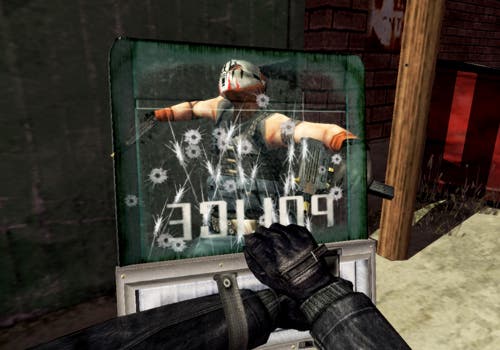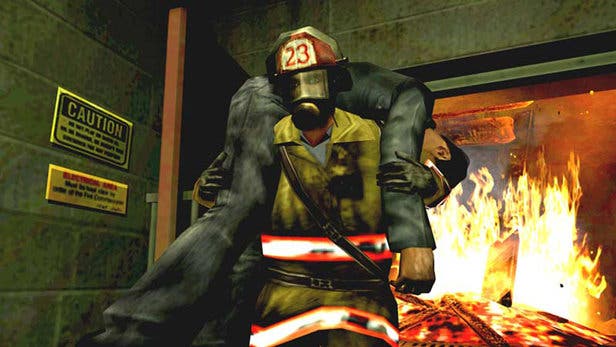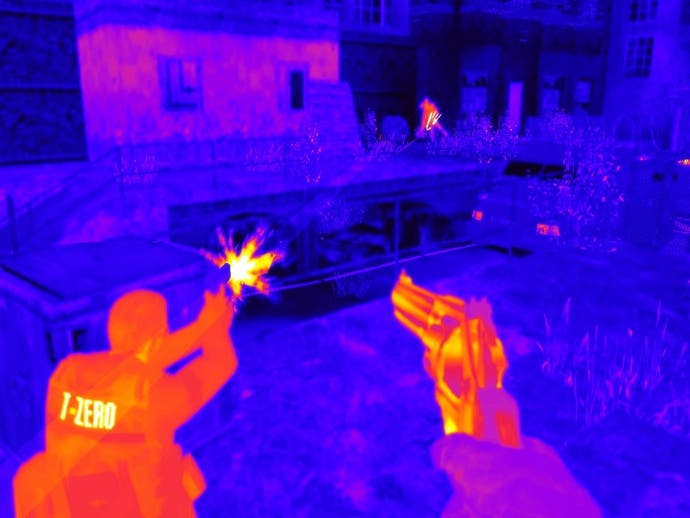Urban Chaos: Riot Response was Rocksteady's pre-Batman crime crackdown
In search of Arkham's origins.
Bruce, almighty. As widescreen summer entertainments go, Batman: Arkham Knight is big, brash and badass enough to mix it with any of 2015's movie blockbusters. It's even been marketed as the conclusion of an epic trilogy, equating London-based developers Rocksteady with popcorn auteurs like Christopher Nolan or Peter Jackson and positioning Arkham Knight as the capstone to some grand, overarching mythos. (This also conveniently sweeps 2013's snowy Arkham Origins, the competent but slightly underwhelming prequel developed separately by Warner Bros Montreal, under the bat-carpet.)
But before Batman: Arkham Asylum rubber-stamped Rocksteady as major industry players in 2009, they'd already created a game where one man attempts to save a beleaguered city from eccentric criminals using a combination of hi-tech gear and down-and-dirty street-fighting. Eidos published Rocksteady's first game in 2006, two years after Sefton Hill and Jamie Walker established the studio. During development, it had been codenamed Roll Call. But when it arrived on PS2 and Xbox, it was rebranded Urban Chaos: Riot Response, which certainly sounds like an exciting collection of words. (The Urban Chaos part was lifted from a forgotten PS1/PC game Eidos had previously published; the Riot Response bit was essentially the player's job description.)

To continue the auteur theory: before you go and see the new Fantastic Four movie, you might rewatch Chronicle, Josh Trank's previous film as writer/director, to see if it helps you get a handle on his reboot. Similarly, the rapturous reaction to Colin Trevorrow's Jurassic World could send intrigued dino-fans back to the director's first movie, the low-budget time-travel tale Safety Not Guaranteed, to try and work out what impressed Spielberg so much he handed over the reins to a beloved franchise. In that spirit, I wanted to return to Urban Chaos: Riot Response - in search of any Batman breadcrumbs. The core Rocksteady crew that created Urban Chaos had a major hand in Arkham Asylum three years later. Could rugged riot cop Nick Mason be a proto-Bruce Wayne?
If sifting for clues to where Rocksteady's head was at in 2006, you could start with their studio credit animation, a brand identity that had been superseded by 2009. In stark, Sin City-style black-and-white, a low-slung camera darts through traffic and garbage cans, catching a burst of sirens and hip hop before dipping through a storm drain and landing on a train carriage with the Rocksteady logo graffitied on the side. It's slick, urban and very, very American.
In fact, Urban Chaos is overwhelmingly American, with the stars and stripes proudly fluttering in the background of menu and loading screens, and the game's narrative of a city under violent siege parcelled out through convincingly US-style live-action newsflashes delivered by "Lani York for Channel 7 News". It creates a convincing, heightened, hawkish flavour. You could almost describe it as comicbook-esque, although Lani retains her professionalism throughout her bulletins even as events escalate from street battles to a nuclear threat. She never quite goes full Ron Burgundy.

Unlike the Arkham series, where the hulking, intimidating presence of Batman on-screen almost restricts the player's third-person view, Urban Chaos is a first-person shooter, albeit one with that seems unusually grounded and physical for the era. As Mason, the newest recruit to elite gangbusting unit T-Zero, you're authorised to use military-grade weaponry and - in the game's signature innovation - issued with a sturdy polycarbonate riot shield to protect yourself. When your shield takes a hit, you're pushed back incrementally, which anchors what could be a floaty shooting gallery in something like reality.
That door swings both ways. If one of the volatile Burner gang - Urban Chaos' cartoonish, malevolent, fire-obsessed cannon fodder - gets all up in Mason's grill, you can satisfyingly shunt them. Considering how many Batman combo accumulators I've lost due to the disruptive nuisance of shield-carrying Arkham goons, it actually feels good to be on the other side of the polycarbonate for a change. Put a successful shield donk on an enemy and the game congratulates you, their body crumpling in slow-motion as the word "BRUTAL" flashes up.
If there was a Who Do You Think You Are? for video game baddies, it wouldn't be an enormous surprise to discover that the Burners share some DNA with the belligerent, criminal himbos of the Arkham franchise: both favour functional overalls accessorised with tattoos, hockey masks and shivs, and both love picking fights with lone vigilantes despite evidence, in the form of a growing pile of broken bodies, that it is a demonstrably terrible idea.
But what really makes the Burners seem like Glasgow-kissing cousins to Batman's Arkham playdates is their common love of profane trash talk. "You're gonna die, pig!" hoot the Burners while you try and pacify them with an automatic shotgun. As the game progresses and your fame as a zero-tolerance stormtrooper of the state grows, the jibes become more personalised. "We're gonna kill you, Mason!" they cry. They also drop F-bombs, which may have contributed to the 18-certificate rating. The constant catcalling is effective, in that it makes you want to neutralise combatants as quickly as possible, just so they'll shut up.

There's a medal system that encourages replaying levels, nominally incentivising both headshots and non-lethal takedowns, even if the unlocks you earn are generally weapon upgrades to speed up killing. Theoretically, it would be possible to go traverse all of Urban Chaos in Batman's aggressively injurious but allegedly non-lethal style. Though you amass a wide-ranging arsenal of shotguns, assault rifles, industrial buzzsaws and nailbombs, Mason can opt to use an highly charged Taser or "riot grenades" that instantly incapacitate opponents to keep the bodycount low. What you can't do is use stealth, and there's no equivalent to Arkham's predator sections where Batman strikes silently from the shadows. Urban Chaos is a frenetic, stand-up fight that requires extensive use of your shield to progress. Though you carry a badge, you are not a detective, or any kind of knight. You are a soldier.
The urban chaos of the title is lurid and magnified. It would take just the slightest nudge to push it into parody. Your demented superior, Adam Wolf - who, with his shades and fondness for blitzkrieg tactics, is a ringer for Wesker from the Resident Evil series - is so right-wing, you begin to suspect that he might have something to do with the attacks, that he's decided the only way America can maintain its strength is to force it into becoming a police state. But - holy spoilers, Batman - it never happens. While you might roll your eyes at the gung-ho narrative, Rocksteady plays a straight bat, never undercutting the shrill register of the story, even though it feels there's a satirical subtext buried in their somewhere.
While it might not exactly be a forgotten classic, there's a cohesiveness and comprehensiveness to Urban Chaos that still impresses, even if the jingoistic tone might leave you cold. It's a professional, well-executed job, and while Rocksteady's storytelling rapidly became more sophisticated, there is a sense of getting a glimpse at their baby photos while you barge and burn your way through an army of caricatured bad boys. If Rocksteady are, as rumoured, planning on hanging up the cape and cowl after Arkham Knight, returning to the punchy but shallow shooting gallery world of Mason would likely be a backward step. But it's still part of a wider origin story, and for that we should be grateful.

